In the realm of construction, the concept of ‘over-inspection’ is often dismissed or underestimated. However, this phenomenon holds significant implications for project productivity and costs, and its roots can usually be traced back to poorly crafted technical specifications and a lack of expertise among personnel.
The Impact of Over-Inspection
Over-inspection in construction projects can significantly hinder productivity and inflate costs. This excessive scrutiny, often stemming from an overcautious approach, leads to delays, increased labor hours, and the unnecessary use of resources. It’s a cycle where the fear of potential flaws results in an overzealous inspection regime that, paradoxically, can create more issues than it resolves.
Poorly Written Technical Specifications: A Root Cause
A major contributor to over-inspection is the presence of vague or overly stringent technical specifications. These documents are crucial in setting the standards and expectations for a project. When they are poorly written, it leaves too much room for interpretation, leading to an inconsistent and sometimes excessive inspection process. For example, adopting ASME B31.1 Power Piping requirements, designed for power plants, for residential buildings’ water heating systems is an excessive standard that results in unnecessary rework and compliance to unreasonable acceptance criteria.
Knowledge Gap and Lack of Prompt Action
The lack of knowledge among the personnel on a project can further exacerbate the issue of over-inspection. When team members are not fully versed in the nuances of the materials and processes they are working with, they tend to err on the side of caution, resulting in unnecessary checks and balances. Moreover, the absence of prompt decision-making can lead to a backlog of inspections, further slowing down the project timeline.
The Solution: Sound Technical Specifications
The key to preventing over-inspection lies in the preparation of robust technical specifications before the tender process. These specifications should clearly outline:
- Roles and Responsibilities: Each party involved in the project should have a clearly defined role and set of responsibilities. This clarity ensures that inspections are carried out by qualified QC and QA individuals in a systematic and efficient manner.
- Materials, Workmanship, and Quality Requirements: Specifications should precisely articulate the requirements for materials and workmanship, aligning them with the project’s scope and scale. This precision helps avoid the pitfalls of over-inspection by setting realistic and relevant standards.
- Reference Standards Aligned with Material Service Conditions and Expected Service Life: The standards referenced in the specifications should be non-redundant and directly related to the materials’ service conditions and the expected service life of the project. This alignment ensures that the inspection criteria are appropriate and not unnecessarily stringent.
In conclusion, while over-inspection may seem like a minor issue, its impact on construction projects is far-reaching. By acknowledging and addressing the root causes – poor specifications, knowledge gaps, and delayed decision-making – the construction industry can mitigate these effects. The formulation of sound technical specifications prior to tender is not just a remedy but a proactive step towards more efficient, cost-effective, and timely project completion.

